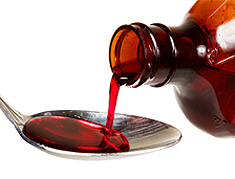Research
December 2, 2010
Children's medicines 'confusing, inconsistent'

A year-long study of 200 top-selling oral liquid over-the-counter medications for children found that most contained variable and inconsistent dosing directions and measuring devices.
Nearly all the products had directions that did not match what was marked on the measuring device. Results of the study are published online and will appear in the Dec. 15 issue of JAMA, the Journal of the American Medical Association. A standardized measuring device was included with 148 of the products examined. Confusing information found in these products include:
• Inconsistencies between dosing directions and markings on the measuring device
• Missing markings on measuring devices; superfluous markings; atypical units of measurement
• Nonstandard abbreviations
• Lack of definitions for abbreviations.
A quarter of the products did not contain a dosing device at all, which means parents could have trouble selecting the right amount of medicine. The study was conducted for the 52 weeks ending Oct. 30, 2009, and included 99 percent of the U.S. market of analgesic, cough/cold, allergy and gastrointestinal OTC oral liquid products with dosing information for children younger than 12. In November 2009, in response to reports of unintentional drug overdoses among children given over-the-counter medicines, the U.S. Food and Drug Administration (FDA) released new voluntary industry guidelines that recommended greater consistency and clarity in dosing directions for OTC medications and their measuring devices.
"This is an issue of patient safety and needs urgent attention," says Ruth Parker, professor of medicine at Emory School of Medicine, who co-led the study.
"Given how many products are affected, it seems unlikely that the voluntary guidelines alone set by the FDA and industry will fix this problem," she says.
"The current guidance does not contain a timeline for compliance or specify consequences for non-compliance. Standards and regulatory oversight will likely be needed to ensure that all products contain label information and dosing device markings that match and are understandable and useful." The FDA voluntary guidelines recommended:
• All OTC liquid medications include a measuring device
• The product's device and directions should use the same abbreviations and units of measurement
• Devices should have only necessary markings
• Devices should not hold much more than the largest dose described
• Abbreviations should be standard and defined
• Decimals or fractions should be used carefully.
The FDA also recommended more research to confirm accurate use of this information by consumers.
